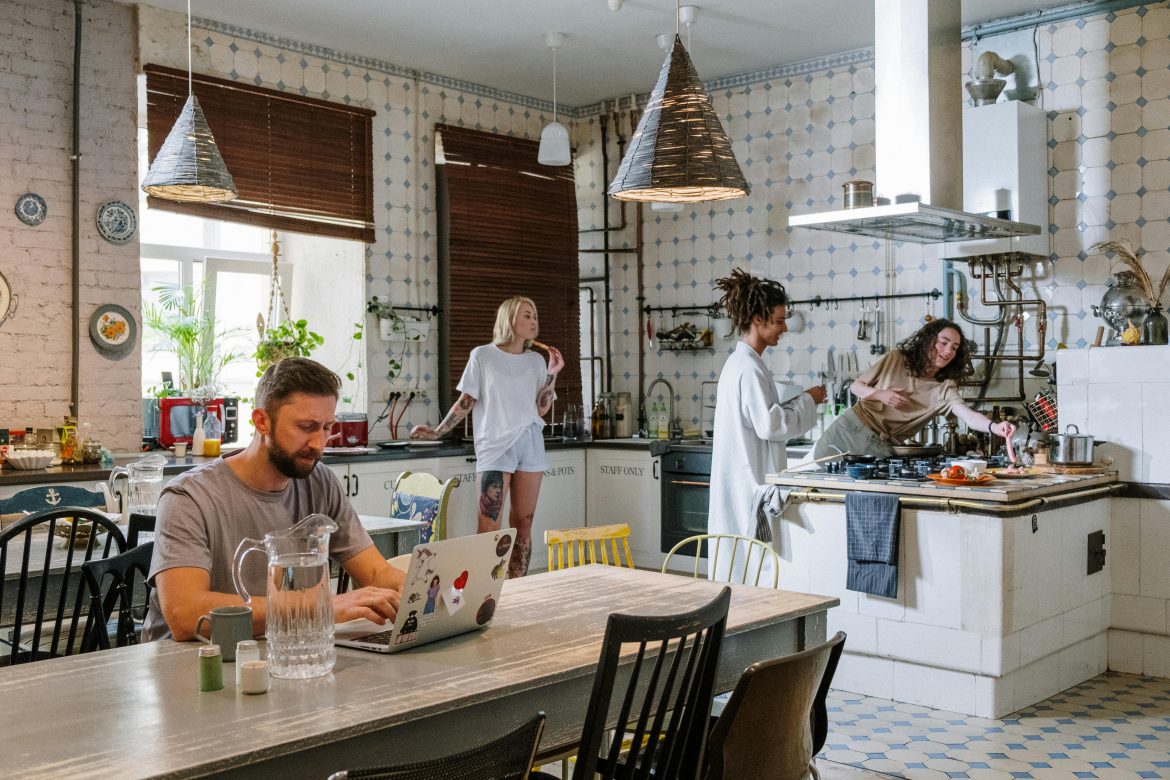Your kitchen isn’t just where you cook — it’s where conversations unfold, guests gather, and everyday life happens. Whether you’re entertaining friends or making memories with family, the kitchen has become the heartbeat of the home. But if yours still feels more functional than inviting, it might be time for a few thoughtful changes.
From clever layouts to cosy lighting, here’s how to transform your kitchen into a warm, welcoming space that people actually want to spend time in.
ALSO SEE: Considering a kitchen island? Here’s how to incorporate one regardless of space
Start with the layout
The best sociable kitchens have a natural flow. That doesn’t mean you need a full renovation — just take a moment to think about how people move through the space. Is there enough room to chat while someone’s cooking? Could you add a small table, breakfast bar or even a moveable island to encourage guests to linger?
If possible, separate your cooking zone from where people gather. This way, you can host without feeling crowded or constantly interrupted.
Add a seating area
Comfortable seating is non-negotiable if you want your kitchen to feel lived-in rather than purely practical. Stools at a countertop, a window bench with cushions, or even a petite table with a couple of chairs can make all the difference.
What matters most is that people have a place to perch, sip a drink and catch up — without being in the way. Soft furnishings like throw pillows or padded seat cushions can help make the space even more inviting.
Keep appliances out of sight
A row of shiny toasters and tangled wires can instantly shift a kitchen’s tone from ‘welcoming’ to ‘worktop chaos’. Tuck away smaller appliances in a cupboard or behind closed doors if you can. Even something as simple as a dedicated tray or larder shelf can help restore visual calm.
A tidier space feels less like a workstation and more like a room for living.
Mix in freestanding furniture
Built-in cabinets will always be practical, but standalone furniture pieces help soften the kitchen’s edges. A freestanding island, sideboard, or even a bookcase makes the space feel more relaxed — and more like a continuation of your home, rather than a standalone cooking area.
Plus, movable furniture allows you to adapt the space as needed when guests are over.
Let your kitchen show some personality
A sociable kitchen shouldn’t feel like a showroom. Open shelves, glass-fronted cupboards, and small display areas give you the chance to add warmth through personal items. Think cookbooks, ceramics, family photos or even a few vintage finds.
By weaving in your story, the kitchen becomes more than just a place to prep meals — it becomes a space that reflects you.
Layer your lighting
Overhead spotlights alone can be too harsh for a relaxed atmosphere. Instead, layer your lighting for comfort and versatility. Combine ceiling lights with pendant lamps over a counter, under-cabinet lighting for prep, and softer accent lamps near seating areas.
This creates a warmer ambiance, and makes the space feel more adaptable — whether you’re hosting a dinner party or having a quiet cuppa.
Soften the edges with texture
Metal and tile might be practical, but too many hard surfaces can feel cold. Add softness wherever you can: fabric blinds, woven bar stools, textured cushions, or a rug underfoot. Natural materials like linen, wood, or clay tones will warm things up visually too.
The goal is to make the kitchen feel like a space to relax in — not just clean up.
Choose hardware that’s both practical and pretty
Handles and knobs are touched daily, often by different people, so they deserve more thought than you might expect. Go for shapes that feel good in your hand, and finishes that complement the rest of your space. Warm brass, aged bronze, or tactile timber all lend a sense of comfort and lived-in luxury.
Subtle, yes — but these are the details that quietly elevate a room.
Use every inch wisely
Even small kitchens can be sociable if every corner is working hard. A fold-down table or built-in bench can turn an awkward nook into a breakfast spot. A small drinks station — whether it’s a cupboard with wine glasses or a shelf with your best teapots — can invite interaction without getting in the way.
It’s not about size, it’s about intention.
Bring the kitchen closer to the rest of your home
For years, kitchens were hidden behind doors. Now, they’re often part of open-plan living, or at least in closer visual contact with adjoining rooms. Lean into that. Let your kitchen decor flow naturally from the rest of your home’s style — with artwork, greenery, and a few thoughtful touches that reflect the way you live.
Because the most sociable kitchens aren’t just about function. They’re about feeling. And when a space feels good to be in, people will always gravitate towards it.
ALSO SEE:
Featured Image: Pexels

